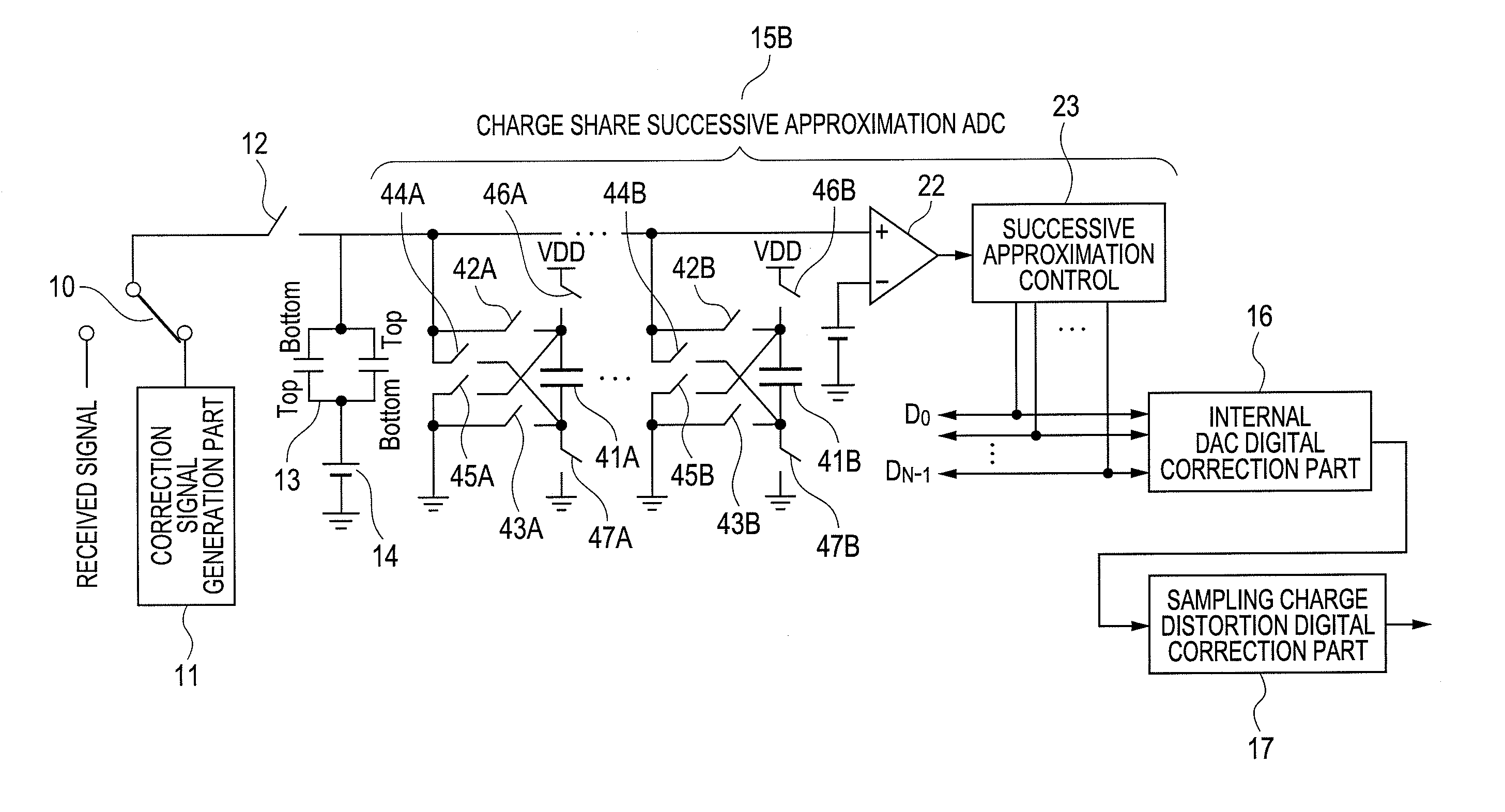Analog-to-digital converter
a converter and analog technology, applied in the field of analog-to-digital converters, can solve the problems of deteriorating effective resolution, insufficient performance of the technology disclosed in the above-mentioned related-art documents, and difficulty in realizing the resolution of 17 bits or more, and achieve the effect of high conversion rate and high resolution
- Summary
- Abstract
- Description
- Claims
- Application Information
AI Technical Summary
Benefits of technology
Problems solved by technology
Method used
Image
Examples
first embodiment
[0036]FIG. 1 illustrates a first embodiment of the present invention. An A / D converter in FIG. 1 includes an input signal changeover switch 10, a sampling part having a sampling switch 12, a sampling capacitor 13, and a bias voltage source 14, a successive approximation A / D conversion part 15, an internal DAC digital correction part 16 connected to a downstream of the successive approximation A / D conversion part 15, a sampling charge distortion digital correction part 17 connected to a downstream of the internal DAC digital correction part 16, and a correction signal generation part 11 that generates a correction signal.
[0037]The successive approximation ADC conducts A / D conversion on charge sampled by the sampling capacitor 13. The sampling capacitor 13 is of a structure in which a first capacitor and a second capacitor each having the same capacitance value are connected in inverse parallel to each other. With this structure, a first-order dependence of the capacitance value on an...
second embodiment
[0054]FIG. 4 illustrates a second embodiment of the present invention. In this embodiment, referring to FIG. 1, the successive approximation A / D conversion part 15 is configured by a charge redistribution successive approximation ADC 15A. In the charge redistribution successive approximation ADC, internal DAC capacitors 21A to 21D also function as the sampling capacitor.
[0055]An A / D converter in FIG. 4 includes the charge redistribution successive approximation ADC 15A which is totally configured by the input signal changeover switch 10, the sampling part having sampling / DAC changeover switches 20A to 20D, internal DAC / sampling capacitors 21A to 21D, the bias voltage source 14, and a reset switch 24, the comparator 22, and the successive approximation control part 23. The A / D converter of FIG. 4 also includes the internal DAC digital correction part 16 connected to a downstream of the charge redistribution successive approximation ADC 15A, the sampling charge distortion digital corr...
third embodiment
[0061]As a third embodiment of the present invention, FIG. 5 illustrates an example of the operation timing. At the time of the digital correction of the internal DAC, the correction signal generation part 11 generates a waveform in which a value is widely changed within an input range of the ADC such as a chopping wave or a sine wave as the internal DAC correction signal, to thereby activate a lookup algorithm of the internal DAC correction factor in the internal DAC digital correction part 16 so that the convergence of the lookup algorithm can be enhanced. Also, at the time of the digital correction of the sampling charge distortion, the correction signal generation part 11 generates DC voltages DC1, DC2, and DC3 having three kinds of voltage values as the sampling charge distortion correction signals. With the use of those DC voltages DC1, DC2, and DC3, the sampling charge distortion digital correction part 17 conducts the digital correction. Specifically, if DC=0 is met, the DC ...
PUM
 Login to View More
Login to View More Abstract
Description
Claims
Application Information
 Login to View More
Login to View More - R&D
- Intellectual Property
- Life Sciences
- Materials
- Tech Scout
- Unparalleled Data Quality
- Higher Quality Content
- 60% Fewer Hallucinations
Browse by: Latest US Patents, China's latest patents, Technical Efficacy Thesaurus, Application Domain, Technology Topic, Popular Technical Reports.
© 2025 PatSnap. All rights reserved.Legal|Privacy policy|Modern Slavery Act Transparency Statement|Sitemap|About US| Contact US: help@patsnap.com



